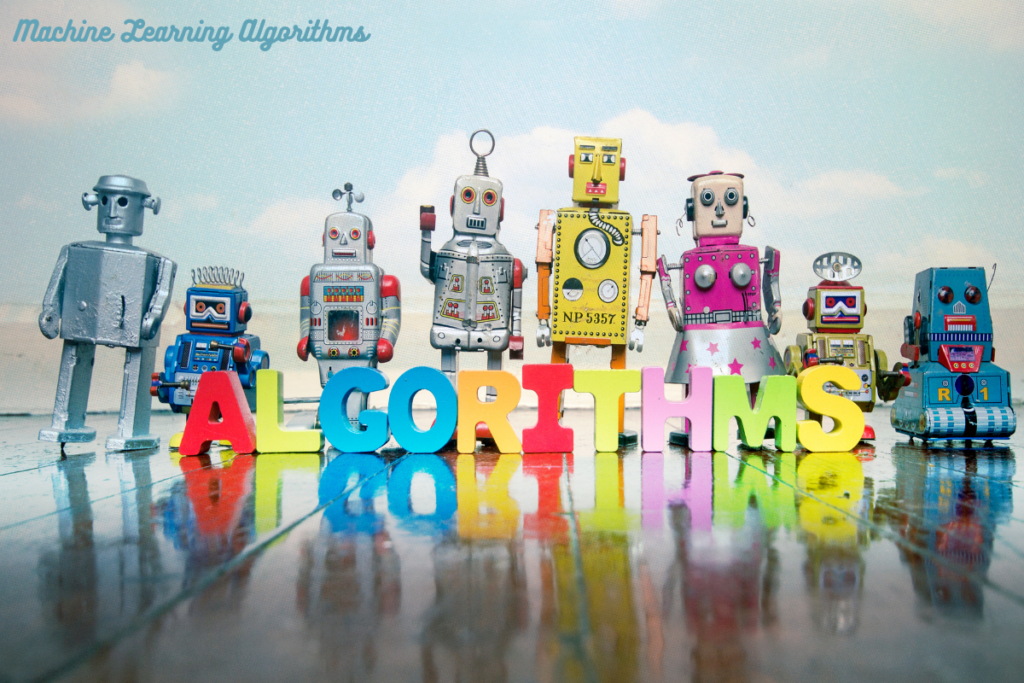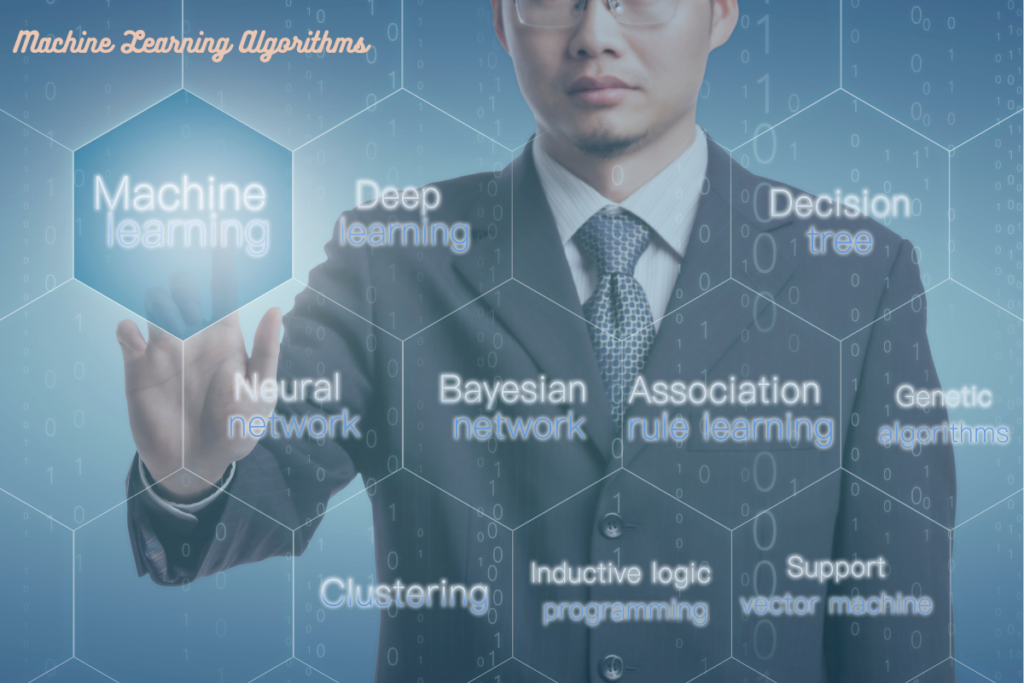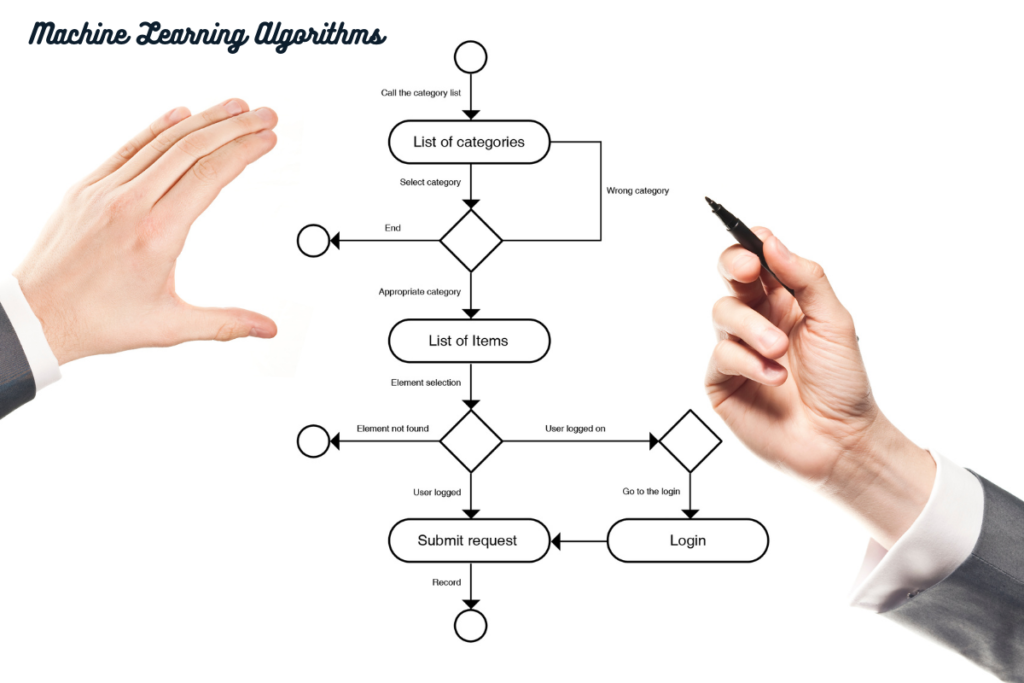Introduction:

Welcome to our complete Machine Learning Algorithms tutorial! Machine learning algorithms drive innovation across industries in today’s fast-changing technology landscape. These algorithms fuel many complex applications, from market trend prediction to recommendation systems.
Learning how machine learning algorithms work is crucial in our data-driven society. These sophisticated technologies automate processes, find patterns, and make insightful judgments from massive data sets. This article will help you understand machine learning algorithms and their applications, whether you’re a data scientist or just starting out.
Explore machine learning algorithms and how they are changing industries, generating innovation, and defining our future.
Table of Contents
Machine Learning Algorithms: A Comprehensive Guide :
From tailored suggestions to self-driving cars, machine learning is everywhere. Machine Learning Algorithms power this revolution.
What are Machine Learning Algorithms?
Machine learning methods allow computers to learn from data without programming. These algorithms predict and act on data patterns and relationships without being explicitly taught. Imagine educating a machine to learn like a person, but much faster and larger.
Why are Machine Learning Algorithms Important?
“Machine learning algorithms” automate complex operations, improve efficiency, and disclose insights humans may miss. This technique benefits several fields. It aids medical diagnosis, prediction, and treatment development. It helps detect fraud, assess risks, and automate trading in finance. In e-commerce, it recommends products, customizes shopping, and optimizes price. In manufacturing, it aids predictive maintenance, quality control, and process optimization.
Types of Machine Learning Algorithms:
While machine learning algorithms are diverse, they can be generically divided into three types:

Supervised Learning:
“Machine learning algorithms” that learn from labeled data try to comprehend the relationship between known inputs and outputs to predict future data outcomes. Some algorithms predict continuous quantities like house or stock prices via regression. Data is classified into specified groups, such as spam emails or photos.
Unsupervised Learning:
A learning algorithm without outputs learns from unlabeled data. This type of “machine learning algorithm” finds data patterns and structures. Clustering related data points can help categorize customers or find anomalies. Dimensionality reduction simplifies data visualization and feature extraction by reducing features.
Reinforcement Learning:
This algorithm learns by interacting with its surroundings and improves through trial and error, collecting rewards or penalties. These “machine learning algorithms” try to optimize a strategy that maximizes rewards over time. Training AI agents to play chess or Go and commanding robots to accomplish complex tasks are examples.
Diving Deeper: Exploring the Different Types of Machine Learning Algorithms:

We introduced “Machine Learning Algorithms” as AI’s driving force. Let’s explore these algorithms’ types and uses.
Classification Algorithms:
These algorithms filter data into predetermined categories like boxes based on features. “Machine learning algorithms” like Decision Trees make feature-based decisions in a tree-like structure and are straightforward to interpret. Support Vector Machines (SVM) are accurate at finding the best class border, especially with high-dimensional data. K-Nearest Neighbours (KNN) classifies data points by proximity to nearby points, making it easy to implement but slow for large datasets.
Regression Algorithms:
These algorithms estimate unseen data values by finding a line that best fits input attributes to anticipate continuous output values. “Machine learning algorithms” like Linear Regression model inputs and outputs as a linear equation, making them easy to grasp and execute, but they may struggle with complex interactions. Ridge Regression is similar but has a cost function penalty term to prevent overfitting and increase generalization.
Clustering Algorithms:
Similar data points are clustered by these algorithms. K-Means and other “machine learning algorithms” cluster data and assign each point to the nearest cluster centroid. Although easy and ubiquitous, it involves predefining the number of clusters. Hierarchical Clustering merges comparable data points to form a hierarchy. More versatile than K-Means, but more computationally intensive.

Association Rule Learning:
These algorithms detect correlations between things in a dataset, like “Customers who buy milk also tend to buy bread.” This information is useful for marketing and recommendation systems. “Machine learning algorithms” like the Apriori Algorithm locate frequent item sets and develop association rules based on support and confidence from the bottom up.
Ensemble Algorithms:
These algorithms use several learners to create a stronger model, like consulting multiple experts to make a better choice. “Machine learning algorithms” like Random Forest use numerous decision trees trained on random data and features to avoid overfitting and increase accuracy. Gradient Boosting Machines are accurate and can handle complex datasets by sequentially building weak learners that correct each other.
Unlocking the Power of Machine Learning Algorithms: Key Concepts and Terminologies
We investigated “Machine Learning Algorithms”’ diversity. Let’s discuss some key terms and concepts needed to comprehend and use these algorithms.
Training and Testing Datasets:
Machine learning relies on algorithms’ data-learning abilities. Two major datasets are used for this learning. Training the machine learning model with the training dataset helps it find patterns and relationships. Using data not observed during training, the model’s performance is assessed using the testing dataset. The model’s testing dataset accuracy shows generalization.
Overfitting and Underfitting:
Model training can cause overfitting and underfitting. Overfitting occurs when the model memorizes the training data instead of detecting general patterns, resulting in poor performance on fresh data due to a lack of generalization. Underfitting occurs when the model fails to learn the training data sufficient to capture the underlying relationships and perform poorly on both the training and testing datasets. These difficulties are crucial for creating “machine learning algorithms”.
Cross-Validation:
To prevent overfitting and ensure model generalization, cross-validation is performed. This method divides data into folds for training and validation. The technique is repeated with different folds. Averaging performance across all folds gives us a strong assessment of the model’s generalization capabilities, which is crucial for “machine learning algorithms”.
Feature Selection and Engineering:
Feature selection and engineering are crucial to the quality of data used to train a machine learning model. Because unnecessary or redundant features might hurt the model, feature selection includes choosing the most relevant and useful dataset features. However, feature engineering transforms current features into new, more significant ones by developing new combinations or performing mathematical modifications to improve “machine learning algorithm” learning.
Choosing the Right Machine Learning Algorithm for Your Project: A Guide
In the exciting field of machine learning, algorithm selection is vital for project success. As a carpenter wouldn’t use a hammer to push screws, using the improper algorithm can reduce performance.
This article will help you understand “Machine Learning Algorithms” and its main elements and measurements.
Factors to Consider:
Different “machine learning algorithms” work better with different data. Unstructured data comprises text, photos, music, and videos like social media postings and medical scans, while structured data contains spreadsheets with arranged rows and columns like consumer purchase history or financial data.
Whether you want to classify data into established classifications, forecast continuous numerical values with regression, cluster comparable data points, or propose relevant items based on user preferences, your project’s goal matters. The amount of data, processing power, and time available will also affect algorithm selection and strategy.
Pros and Cons of Different Algorithms:
Different “machine learning algorithms” have pros and cons. Simple and easy to read, linear regression is sensitive to outliers. Logistic Regression is resilient and efficient and utilized for binary classification. Decision Trees are simple and can handle numerical and categorical data, but they may overfit. Random Forests are resilient to noise and reduce overfitting using ensemble methods.
Support Vector Machines (SVMs) can perform complex categorization problems but are computationally intensive. Neural networks are accurate and can learn complex patterns, but they need vast datasets and computer power. Finally, K-Means Clustering is simple and effective yet sensitive to initial cluster center settings.
Performance Metrics to Evaluate Algorithms:
Several criteria are used to evaluate “machine learning algorithms”. Model accuracy measures the percentage of correct predictions. Precision is the percentage of positive predictions that were correct. The percentage of accurately predicted positive cases compared to all positive cases is recall.
The harmonic mean of precision and recall balances them in the F1 Score. In regression problems, the Mean Squared Error (MSE) determines the average squared difference between predicted and actual values to evaluate model performance.
Machine Learning Algorithms: Shaping Our World, One Application at a Time
Machine learning is becoming part of our daily life. From online tailored suggestions to self-driving automobiles, “Machine Learning Algorithms” are quietly advancing many fields and transforming the word for “Living with AI”. This shows how they’re changing the world:
Healthcare:

“Machine learning algorithms” enable predictive diagnosis by assessing patient data including medical history, symptoms, and test findings to forecast illness risk. This allows early intervention and customized treatment.
These algorithms can search enormous chemical compound datasets for therapeutic candidates, speeding up drug development. Machine learning helps interpret medical imaging including X-rays and MRIs for faster, more accurate cancer diagnoses.
Finance:
Finance uses “machine learning algorithms” for many purposes. These algorithms recognize unique financial transaction patterns to detect and prevent fraud. Machine learning helps banks and financial organizations identify credit risks and make better lending decisions. These algorithms assess market data and execute transactions automatically to optimize returns and minimize risk in algorithmic trading.
E-commerce:
E-commerce and marketing are using “machine learning algorithms” to improve user experiences and revenues. Recommendation systems use browser history, buying trends, and preferences to propose things customers might like, increasing sales and satisfaction.
Personalized marketing uses machine learning to target specific client categories, improving targeting and campaign success. Pricing optimization systems also alter prices dynamically based on demand and rival pricing, maximizing revenue.
Autonomous Vehicles:
“Machine learning algorithms” evaluate camera photos and videos to detect cars, pedestrians, and traffic signs, ensuring safe navigation in autonomous vehicles.
These algorithms control the vehicle’s speed, lane changes, and brakes in real time. Machine learning can manage traffic flow by evaluating data to reduce congestion and trip times, improving transportation efficiency for the “Self Driving Cars”,
Beyond these examples:
“Machine learning algorithms” are improving efficiency and productivity in agriculture and manufacturing. These algorithms improve farming by predicting crop yields, optimizing irrigation, and detecting crop illnesses. They predict machine faults, streamline production, and improve quality control in manufacturing, improving product quality and reducing downtime.
Environmental Monitoring:
Satellite data analysis for climate change, air quality, and disaster prediction.
The Future of Machine Learning Algorithms:
Machine learning applications will grow, affecting many facets of our lives. From personalized healthcare to intelligent cities, “Machine Learning Algorithms” will advance and change the future.
Building Your Machine Learning Toolkit: Essential Tools and Libraries
Machine Learning Algorithms is a huge and complex world, but you don’t have to explore it alone. You can develop, train, and deploy models efficiently using powerful tools and frameworks. Here are some essential machine learning toolbox components:
Popular Machine Learning Libraries:
Many prominent libraries provide “machine learning algorithms” for model development. Google’s TensorFlow is a strong open-source library for numerical computing and large-scale machine learning, excelling in deep learning and complex neural network development.
Scikit-learn, another simple framework for classical machine learning techniques including classification, regression, and clustering, is great for beginners and experts. Facebook-developed PyTorch includes a dynamic computation graph for experimental and bespoke model creation and promotes flexibility and research.
Tools for Data Processing and Visualization:
Working with Python “machine learning algorithms” is improved by several libraries. Pandas’ DataFrames and tools to clean, transform, and explore datasets simplify data preparation for machine learning models.
Matplotlib is used to create static, interactive, and animated visualizations including line charts and scatter plots to analyze data and evaluate model performance. Seaborn, built on Matplotlib, makes it easy to create attractive and statistically informative charts to depict variable connections and compare groups.
Why These Tools Are Important:
By simplifying data processing, model training, and evaluation, “machine learning algorithms” libraries and tools boost productivity. Large datasets and sophisticated models are handled well, making real-world problems easier to solve.
These libraries also allow customers to customize their solutions with a wide range of functionality and customization possibilities. The strong communities around these open-source libraries provide significant learning and troubleshooting tools, making them invaluable for field workers.
The Future of Machine Learning Algorithms: Challenges, Trends, and Ethics
“Machine Learning Algorithms” have transformed several industries, but their path continues. We face new difficulties and fascinating future trends as we push AI’s limits.
Ethical Considerations:
Working with “machine learning algorithms” requires addressing several significant challenges. Models might inherit biases from training data, resulting in discriminatory outcomes, so we need strategies to minimize prejudice and assure fair decision-making.
Privacy and security need appropriate data collection, storage, and use to protect personal information and prevent misuse. Finally, many machine learning models are “black boxes,” making their judgments hard to understand, therefore improving transparency and explainability is crucial to gaining trust in them.
Current Limitations and Ongoing Research:
“Machine learning algorithms” face significant obstacles. These models require vast amounts of data for training, thus methods that can learn from smaller datasets or adapt to changing data environments are needed.
Another issue is generalization, as models trained on specific data may struggle to predict new data, requiring research to improve their generalizability. Researchers are developing methods to make complex models more interpretable since understanding why a model generates certain predictions is critical for trust and accountability.
Future Trends in Machine Learning Algorithms:
Several promising “machine learning algorithms” are being developed to improve their efficacy and usefulness. Explainable AI (XAI) develops methods to make AI systems more human-friendly. Federated learning lets models be trained on decentralized datasets without exchanging sensitive data, improving privacy. Few-shot and zero-shot learning strive to create models that can learn from minimal data or no training samples.
Autonomous systems and robotics benefit from reinforcement learning, which trains algorithms through trial and error like humans do while playing games. Finally, academics are investigating quantum machine learning to accelerate and improve these methods with quantum computing.
Conclusion:
“Machine Learning Algorithms” are changing the world by predicting weather and powering self-driving cars. These algorithms help machines learn, adapt, and make smart judgments by using data and computation.
As we’ve seen, machine learning is large and complex. We’ve explored the key elements, tools, and applications that drive this intriguing field, from understanding algorithms to choosing the perfect one for your project.
We’ve acknowledged this amazing technology’s ethical issues and limitations. Addressing these issues and embracing new trends will help us use “Machine Learning Algorithms” to tackle complicated problems and improve the world.
The machine learning journey has just begun. As we learn and innovate, the possibilities are unlimited.
People also ask:
1. Linear Regression: Fits a linear equation to data to model variable relationships.
2. Decision Trees: Classification or regression using a tree-like decision model.
3. Random Forest: Improves accuracy and stability by combining decision trees.
4. K-Means Clustering: Clusters related data.
5. Support Vector Machines (SVM): Finds the optimal categorization hyperplane.
Machine learning algorithms are computer programs that can learn patterns from data and use them to make decisions or predictions. They can be used for jobs like clustering, classification, regression, and reinforcement learning.
Pingback: From Data to Decisions: The Power of Machine Learning
Can you be more specific about the content of your article? After reading it, I still have some doubts. Hope you can help me.